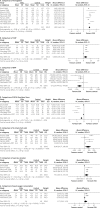Effects of erythropoiesis-stimulating agents on heart failure patients with anemia: a meta-analysis
- PMID: 27625688
- PMCID: PMC5011541
- DOI: 10.5114/aic.2016.61647
Effects of erythropoiesis-stimulating agents on heart failure patients with anemia: a meta-analysis
Abstract
Introduction: Heart failure (HF) is always complicated with anemia and is associated with bad prognosis in this patient population. Several studies have assessed the potential role of erythropoietin-stimulating agent (ESA) in improving cardiac function and reducing the number of hospitalizations in anemic patients with HF.
Aim: We performed a meta-analysis to assess the potential role of ESA in the treatment of anemic patients with HF.
Material and methods: A literature and Medline search was performed to identify studies with control groups that examined the efficacy of ESA therapy in patients with HF and anemia.
Results: A total of 11 studies were included (n = 3044 subjects) in the final analysis. Compared to placebo, ESA therapy was associated with increased hemoglobin levels (1.89 g/dl; 95% CI: 1.64-2.14, p < 0.00001), increased left ventricular ejection fraction (LVEF) to 6.88 (95% CI: 0.49-13.28, p = 0.03), decreased B-type natriuretic protein (-272.20; 95% CI: (-444.52)-(-99.89), p = 0.002), improvement in New York Heart Association functional class to -0.33 mean difference (95% CI: (-0.44)-(-0.23), p < 0.00001), and decreased hospitalization (OR = 0.61, 95% CI: 0.39-0.94, p = 0.02). There was no significant between-group difference in all-cause mortality (OR = 0.78, 95% CI: 0.51-1.21, p = 0.27).
Conclusions: The treatment of anemia with ESA therapy did not reduce the rate of all-cause mortality among patients with heart failure, but ESA therapy made a potential important contribution to patients' symptomatic improvement.
Keywords: anemia; erythropoietin-stimulating agents; heart failure; meta-analysis; randomized controlled trials.
Figures



Similar articles
-
Erythropoiesis stimulating agents in heart failure patients with anemia: a meta-analysis.Cardiovasc Drugs Ther. 2009 Dec;23(6):511-8. doi: 10.1007/s10557-009-6203-6. Cardiovasc Drugs Ther. 2009. PMID: 19862609
-
A randomized, placebo-controlled trial of pentoxifylline on erythropoiesis-stimulating agent hyporesponsiveness in anemic patients with CKD: the Handling Erythropoietin Resistance With Oxpentifylline (HERO) trial.Am J Kidney Dis. 2015 Jan;65(1):49-57. doi: 10.1053/j.ajkd.2014.06.020. Epub 2014 Aug 10. Am J Kidney Dis. 2015. PMID: 25115616 Clinical Trial.
-
The effects of erythropoiesis stimulating therapy for anemia in chronic heart failure: A meta-analysis of randomized clinical trials.Int J Cardiol. 2016 Sep 1;218:12-22. doi: 10.1016/j.ijcard.2016.04.187. Epub 2016 May 11. Int J Cardiol. 2016. PMID: 27209352
-
[Diagnosis and treatment of anemia in heart failure patients].G Ital Cardiol (Rome). 2011 May;12(5):319-26. doi: 10.1714/643.7496. G Ital Cardiol (Rome). 2011. PMID: 21593950 Review. Italian.
-
The role of erythropoietin stimulating agents in anemic patients with heart failure: solved and unresolved questions.Ther Clin Risk Manag. 2014 Aug 13;10:641-50. doi: 10.2147/TCRM.S61551. eCollection 2014. Ther Clin Risk Manag. 2014. PMID: 25143739 Free PMC article. Review.
Cited by
-
Hypoxia-inducible factor prolyl hydroxylase inhibitors for anemia in heart failure patients: A protocol for systematic review and meta-analysis.PLoS One. 2022 Sep 28;17(9):e0275311. doi: 10.1371/journal.pone.0275311. eCollection 2022. PLoS One. 2022. PMID: 36170343 Free PMC article.
-
Anemia and Heart Failure: A Narrative Review.Cureus. 2022 Jul 23;14(7):e27167. doi: 10.7759/cureus.27167. eCollection 2022 Jul. Cureus. 2022. PMID: 36017290 Free PMC article. Review.
-
The Potential of SGLT2 Inhibitors to Counteract Anemia in Patients with Heart Failure.J Gen Intern Med. 2025 Feb;40(3):723-724. doi: 10.1007/s11606-024-09096-9. Epub 2024 Nov 7. J Gen Intern Med. 2025. PMID: 39511119 No abstract available.
-
Effects of a single bout of exercise on human hemocytes and serum interleukin 3, erythropoietin, and soluble transferrin receptor in a hot and humid environment.PeerJ. 2024 Nov 29;12:e18603. doi: 10.7717/peerj.18603. eCollection 2024. PeerJ. 2024. PMID: 39624122 Free PMC article. Clinical Trial.
-
Targeting Inflammation and Iron Deficiency in Heart Failure: A Focus on Older Adults.Biomedicines. 2025 Feb 13;13(2):462. doi: 10.3390/biomedicines13020462. Biomedicines. 2025. PMID: 40002874 Free PMC article. Review.
References
-
- Lindenfeld J. Prevalence of anemia and effects on mortality in patients with heart failure. Am Heart J. 2005;149:391–401. - PubMed
-
- Ghali JK. Anemia and heart failure. Curr Opin Cardiol. 2009;24:172–8. - PubMed
-
- Caira C, Ansalone G, Mancone M, et al. Heart failure and iron deficiency anemia in Italy: results from CARMES-1 registry. Future Cardiol. 2013;9:437–44. - PubMed
-
- Groenveld HF, Januzzi JL, Damman K, et al. Anemia and mortality in heart failure patients a systematic review and meta-analysis. J Am Coll Cardiol. 2008;52:818–27. - PubMed
LinkOut - more resources
Full Text Sources
Other Literature Sources
Research Materials
Miscellaneous
